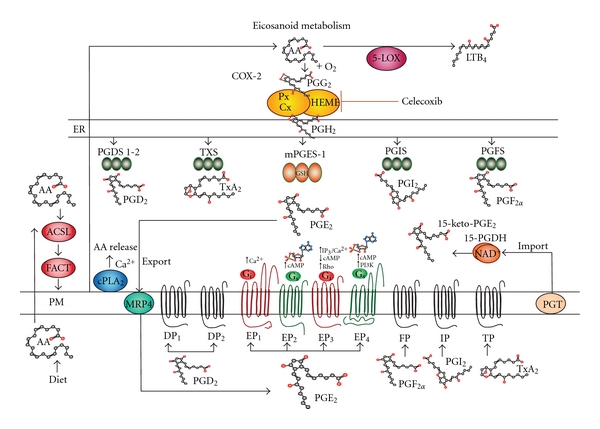Figure 1.

Eicosanoid metabolism. Arachidonic acid (AA) is an essential dietary fatty acid that is transported into cells and stored in membrane phospholipids. First AA is coupled to acyl-CoA by acyl-coenzyme A synthetases (ACLS). Fatty acyltransferases (FACT) then insert AA into membrane phospholipids. Cytoplasmic phospholipase A2 (cPLA2) releases AA from membrane phospholipids after agonist stimulation. In turn, free AA is converted to prostaglandin G2 (PGG2) and then prostaglandin H2 (PGH2) by cyclooxygenases (COXs). PGH2 then becomes a substrate for a variety of PG synthases. These PG synthases are identified by the specific prostaglandin each one produces, namely, PGD2 synthases (PGDSs), PGE2 synthases (PGESs), (PGF2α) synthase (PGFS), PGI2 synthase (PGIS), or TxA2 synthase (TXS). Both COX-2 and microsomal PGE synthase-1 (mPGES-1) are elevated in tumors. Export involves multidrug resistance-associated protein 4 (MRP4). In the extracellular milieu, PGs bind to G-protein-coupled receptors identified as DP1, DP2, EP1-4, FP, IP, and TP. Among these, EP receptors interact with G-stimulatory (Gs) or G-inhibitory (Gi) proteins stimulating downstream signals such as cAMP, Ca2+, inositol phosphates or IP3/Ca2+, and Rho. Catabolism involves uptake by PG transporter (PGT) and inactivation by NAD+ dependent 15-hydroxyprostaglandin dehydrogenase (15-PGDH).
